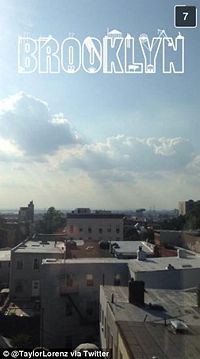Snapchat
From DigitalRhetoricCollaborative
Contents |
History
Snapchat was first launched in July 2011 as Picaboo, the name was shortly rebranded as Snapchat during the same year. In 2012 the application was released on Android devices shortly followed by an Apple ISO release.[3] The application quickly grew in popularity and by late 2013 the first major update to the application was launched. The update enhanced the speed and design of the application allowing for swipe navigation, a double-tap reply option for users and an improved friend finder - creating a more fluid interface. [4] In early 2013 the application launched another update that enabled users to send and alter video snaps and added a text message feature which allowed users to correspond both privately and publicly. The next update introduced the My Story feature of the application which allowed users to post snaps that could be viewed by their whole network instead of single selected friends. Today the application includes features such as customizable text, geo flitters, photo filters and multi-color drawing modes that allow the user to interact with their environment and then disseminate the information to a mass grouping of people or a selected individual.
Features
The features of Snapchat allow users to enhance, diminish or recontextualize their environments and produce, for a second party, a hyper focused and mediated glimpse into their day-to-day life. All photo manipulating features are added to the image after the picture is taken, but before the snap is sent. These features include Text, Color Drawing, Image Filters and Geo Filters.
Text
In the application, users can add text by tapping on the image and then using the built-in keyboard to add a preselected amount of characters. The application links with the keyboards installed on the users phone which allows for multiple language capabilities, including Emojis. The default text is displayed on top on the image set within a semi-transparent gray box. Updates to the application in 2013 and 2014 have allowed for higher customization for added text. On the top right corner of the screen is located a large T. By tapping this icon the user rotates through different text display options that include the default text, a bolded text that is left-aligned and the same bolded text that is center-aligned. With the two bolded text options, the user can manipulate the size, color and angle of the text my pitching a pulling the texts on the screen.
Color Drawing
Color drawing, along with the default text feature, were the first two elements that Snapchat introduced for enhancing the Snap image. Located on the top right of the screen, next the text box, is an icon that mimics a crayon. By tapping this icon a color gradient appears on the screen and the touch mechanism on the phone allows the user to draw on top of the image just captured. The user can add multiple layers of color by pressing and dragging their finger up and down the color gradient and then continue to draw on top of the image. Recent updates to the application have added more color options including black, white, and grays of the respected base colors. The user selects these colors by pressing and dragging the color gradient to the bottom left corner and the top left corner of the screen.
Image Filters
Once the image is captured, Users can swipe with one finger to the right of the image to enable the 3 different Image Filters embedded into the application. The first filter adds a warm and saturated mask over the image. the second filter adds a cool blue mask with saturated highlights and the third filter turns the image into a traditional black and white photograph. These filters can not be combined with any other filters including Geo Filters but can be enhanced with added text and color drawing features.
Geo Filters
In 2014, Snapchat added a second set of filters called Geo Filters. Geo filters are location dependent which is formulated using the GPS settings in the users' phones. The filters are represented by mask images that can be set over the taken snap. To access these filters, one must swipe to the lift or right of the screen once the image has been taken. The first Geo filters included a large digital clock that displayed the current time of the snap, a speedometer that used GPS tracking to display the speed in which the user was traveling when the image was taken, and a thermometer that displayed the current temperature in either Celsius or Ferinhight.
Most recently these Geo Filters have expanded into, what Snapchat is calling, neighborhoods [5] The application uses GPS to identify where the user is located and then draws from a bank of predesigned images that are only available to users located within the predetermined coordinates. Many major cities and landmarks have Geo filters, and by using the feature, users can inform recipients of the snaps where they are located and also create a network of correspondence that have a common filter location. Like the Image Filters, these images can not be combined with other filters but can be enhanced with the text and color drawing tools.
Common Uses
Snapchat is a tool for communication. A debate surrounds the functionality and usage of Snapchat with one party arguing that the main mode of communication on the application is personal and intimate, while the other party argues the users of the app are more prone to mass communication and less intimate correspondence. Snapchat has been spoken and debated as both a tool for sexing, and on the opposite spectrum, group messaging. These two modes of Snapchating are both feasible with the Affordances of the application, but it remains a constant debate what users truly use Snapchat to communicate. Researchers at the University of Washington created a survey that showed only 1.6% of Snapchat users have admitted to using Snapchat as a tool for sexual interaction, while a larger majority, 59.8%, has reported using Snapchat as a mode of transmitting funny or mundane content.[6] Because of Snapchat’s ephemeral appearance some users are unaware that the images that are sent for a limited duration can be saved as a screen shot on the receiver’s phone, and also retrieved from the larger Snapchat database that stores all deleted images. This misunderstanding of Snapchat’s functionality keeps the debate ongoing, in regards to Snapchat usage, despite data that points in either direction.
External Links
References
- ↑ http://www.businessinsider.com/how-many-snaps-snapchat-users-get-2013-11
- ↑ http://blog.snapchat.com/page/5
- ↑ http://techcrunch.com/2012/10/29/billion-snapchats/
- ↑ http://mashable.com/2013/06/06/snapchat-update/
- ↑ http://blog.snapchat.com/page/2
- ↑ Roesner, Franziska, Brian T Gill, and Tadayoshi Kohno. “Sex, Lies, or Kittens? Investigating the Use of Snapchat's Self-Destructing Messages”. Financial Cryptography and Data Security Conference, 2014.
--Jamisone@uga.edu 02:29, 23 April 2015 (EDT)


